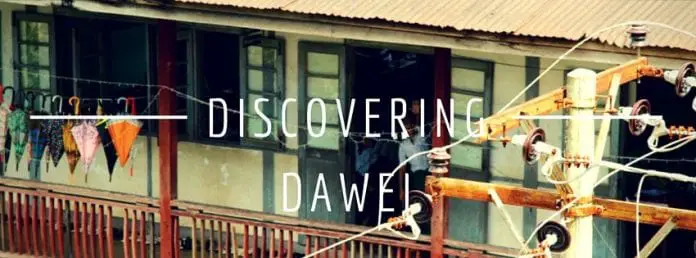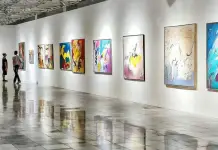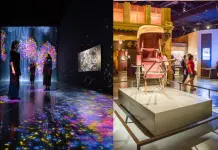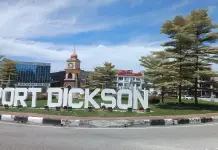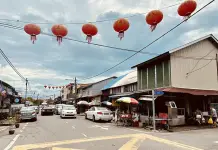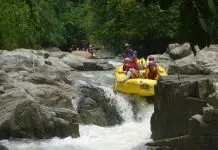This article originally appeared on tinywanderer.com
Mornings in Dawei city start with a hearty breakfast at our hotel.
At Shwe Moung Than hotel, the $18 per night price tag not only offers a lovely double-room with a private bathroom, but also daily breakfast at the highest floor. The breakfast menu varies so everyday is a pleasant discovery of local Burmese dishes. The van driver who drove us from Htee Khee border town to Dawei sure knows the best places to stay in.
Today, it’s a traditional breakfast (apparently especially among the poor) called htamin jaw, fried rice with boiled peas (pè byouk) and green tea (yei nway jan).
As Chris and I dig into our fluffy rice, the hotel manager strides over in his longyi. Mr. Aung Soe has been very kind and generous with his advice for the past few days. Now, he waves and asks if he could join us. There are no other foreigners at the dining area so we welcomed him to our table.
“I need your help,” he starts. “There will be a big group of Thai tourists coming to Dawei for a convention in November. How can I advertise this hotel so that they will come and stay here? What can I put on the board outside?”
It seems like Mr. Aung Soe is requesting for my advertising expertise, and my copywriting skills. Shrewd man, how did he know?
Soon, breakfast turns into a lively discussion on how to craft the best advertising angle for the hotel, his life and the current situation in Myanmar. Mr. Aung Soe originally was a fisherman for a large corporation. After the waters nearby were all fished out, his company sent him to manage the hotel division. He points to his shirt and says that here, he has to wear a shirt, speak to guests all the time and be on-call. His job as a fisherman however, finished at 6pm and then he could relax. He could have drinks with his colleagues and then go home. As a hotel manager, it isn’t so easy.
Life was simpler then, he reminisces. He much prefers to be a fisherman. His brow knits and his eyes see into the past. He is somewhere else. Then, he lifts his glasses off the bridge of his nose and starts wiping them.
Myanmar is not going anywhere, he says, despite the rapid development and the recent change in the policies. The government cronies are pocketing a lot of money, leaving many independent suppliers poor. The gap between the rich and the middle class is massive. Even electricity in Dawei is privatised; the residents of Dawei pay more than people living Yangon.
“Look at Vietnam! They are doing so well now! Here, here–they only care about power!”
My knowledge of Myanmar is still limited and I hunger to fill the gaps but without English or Burmese fluency, I cannot properly take part in the discourse. In between mouthfuls of rice, I noticed his apparent frustration. Mr. Aung Soe continues to talk and reveal more of his life and his hopes for Myanmar. Despite our stilted conversation, I understand him. He seems to enjoy sharing.
Eventually, Mr. Aung Soe passes his business card to me and writes the name of his son and the name of the hotel in Yangon that he’s working part-time in. Fame Hotel.
“Call my son if you need a cheap place to stay in Yangon. It’s close to Shwedagon Pagoda, you know? Call him-best price, I promise!”
***
Everyday Dawei

At 9 in the morning, the sun is already burning. We decide to walk randomly, without a plan in mind. For the past few days, we have always walked past the nearby primary school.
Here, we hear school kids singing, laughing and during breaks, playing within the school’s compound. They shout and wave each time they see us. We must have looked strange to the kids in this part of the world: a tall white Caucasian male and a short tanned Asian female walking hand in hand.

Kids yelling to us, even if lessons are still going on!
Dawei or formerly known as Tavoy (back in the heydays of the British empire), located in Southeastern Myanmar, has only recently opened up. It was supposed to be a sleepy port town but that must be ages ago because the town centre is bustling!
Previously, foreigners were not able to travel overland from Yangon to the South without special permits. However, we still haven’t seen many foreigners so far. The only foreigners we have seen, one or two of them, probably works with the Norwegian NGO nearby. There are no other backpackers or camera-totting tour groups. Maungmagan Beach is 15 minutes away on a motorbike–they might have all gone there.

Just the sort of things that you’ll see around


We reach the main crossroad, where the traffic flows into the most random directions and ways. Between the moving vehicles, we weave in and out, while meandering along the broken and bloodied-by-betel-spit pavements.
Little shops of every kind flank the two sides: hardware shops, clothing boutiques, grocery stores, mechanic workshops, barbers, shops-that-have-every-sort-of-plastic-ware, rice and grain shops, pharmaceutical kiosks, women on sewing machines outside the tailor shop, and most importantly–betel kiosks.
The streets are painted red because of the popular local habit of chewing areca nut wrapped in betel leaf and the spitting that comes after. At the kiosks, fresh packages of these are made with deft fingers. With a brush of slake lime smeared across a betel leaf, a thin areca nut in the middle, a sprinkle of tobacco and other spices over it, you’ll have a powerful stimulant package to chew for hours.


Shops that sell just about anything and everything
Mingalabar! Hallo! Mingalabar! Where you from?
An old lady, manning a sack of leafy vegetables, calls out, asking us to look at her greens. Women, in their flowery longyis and tight blouses, walk past us and sometimes stare. In groups, sometimes they giggle and whisper.
I would have been able to walk the streets without being stared at but unless Chris wraps himself up like a zombie, we contend to feeling like zoo animals. I encourage open curiosity but under intense scrutiny, I feel like digging a hole in the ground and hide.
But perhaps, we are not too different ourselves. After all, we are the ones who shove big camera lenses into the faces of the ordinary folk. We too, stare back and click the shutter button so that we have our own souvenirs of the moments. Different from the outside but really, we are same-same.
***
Into a Local Tea Shop
When the sun becomes unbearable and the air fills thick with humidity, we escape into one of the teashops. From the outside, it looked dim. However, a few steps into the teashop, a vibrant scene unfolds in front of us. Lively chatter and clattering of ceramic cups fill the dank space. Squashed pink napkins–the dry and leathery sort–and small transparent bags litter the cement floor. There is only sunlight filtering through the open doorways. Mr. Aung Soe was right: perhaps electricity is expensive here. Short yet masculine silhouettes dart around with plastic plates of Burmese-Indian pastries and cups of sweet milk tea(le pei ye). I soon realised that among the customers, groups crowding around different tables, I am the only female present. But here, no one stared at us. Conversations didn’t halt; the men are deep in their conversation.
A stocky dark-skinned man behind the cash and cigarette counter beckons us in, when he sees us hesitating. Under his thick moustache, he smiles and points to the nearest unoccupied wooden table. Opposite, a purring cold drinks display fridge stands. Red Coca-Cola cans and orange bottles of Fanta stock the shelves. The local Burmese lemonade and cola brands that I used to know are gone. I wonder what happened to those labels, now that international brands have already infiltrated the Burmese food and beverage market.
My hair is flat and matted with sweat and oil while Chris’ white shirt is completely drenched in perspiration. Above us, the rusty iron fan starts to whir–the stocky man (the Manager, I assume) has turned on the fan for our benefit. Thoughtful. Chris sighs in relief and gratitude; what a solace it is to be out of the blazing streets!


Weary but happy.
We pour ourselves a cup of hot Chinese tea from the steel teapot and then, when the Manager stops by our table, we order two cups of sweet tea. From our recent days in Myanmar, we’ve learned that the flasks or steel teapots that hold Chinese tea in them are complimentary, while tea with condensed milk has to be ordered and charged to the bill. Still, they cost almost next to nothing: 200 Kyats (20 cents) at most.
With the cups of tea, come plates of variety of sweet puffs and buns wrapped in transparent plastic bags. We pick at our sweet snacks, savour our thick milky tea and let the minutes fritter away.
I feel a rush of a familiar feeling. Home–it feels like home.
***
School is Over!
It is now late afternoon and the school bell has just rung. We are walking back to the hotel. Using a different route back, we find the main roads awash with secondary school students cycling back home. Those without bicycles or motorbikes, walk in groups of three or four. Most girls, even while cycling, hold an umbrella above their heads to protect their skin–what a graceful feat.



***
In Dawei, the beauty lies not within the pristine landscapes but rather in the peeling colours of old stucco mansions; the chaos of randomness, antiquity and culture; the perpetual dust and grime that serve as a background for street life to thrive and bloom.
It’s a stunning mess and I love it.
This is the Myanmar that I have come for. For all that mad action, bustling traffic and developing changes, a sense of innocence still prevails. Residents go about their normal lives with integrity and dignity. Locals remain curious of the world outside their own. English is not spoken apart from hotel staff. Those selling food and bus tickets may know a few words but if you pry with further questions, you’ll usually just get a repetition of what you’ve just said or yes, yes!
I will later travel northwards and find that most touristy spots are now blemished with tourists and hustling peddlers. Don’t get me wrong. Those places are still amazing and worth exploring, but that land-trapped-in-time feeling–that was once unique to Myanmar–is slowly fading.
But in Dawei, it’s very much alive.

Practical Information
- Busses travels regularly between Yangon and Dawei. 15,500 Kyats ($15.50) for a (supposedly)18-hr journey to Yangon.
- Tip: Try to book a Scania-make bus as it’s guaranteed to be more comfortable. Unfortunately for us, we had no idea then and had to suffer a long and traumatic bus journey. Discomfort was an understatement. I’ll leave that story for another day.
- Feel free to break your trip up by putting up a night or two at Mawlamyine.


